Family : Orchidaceae

Text © Prof. Pietro Pavone

English translation by Mario Beltramini
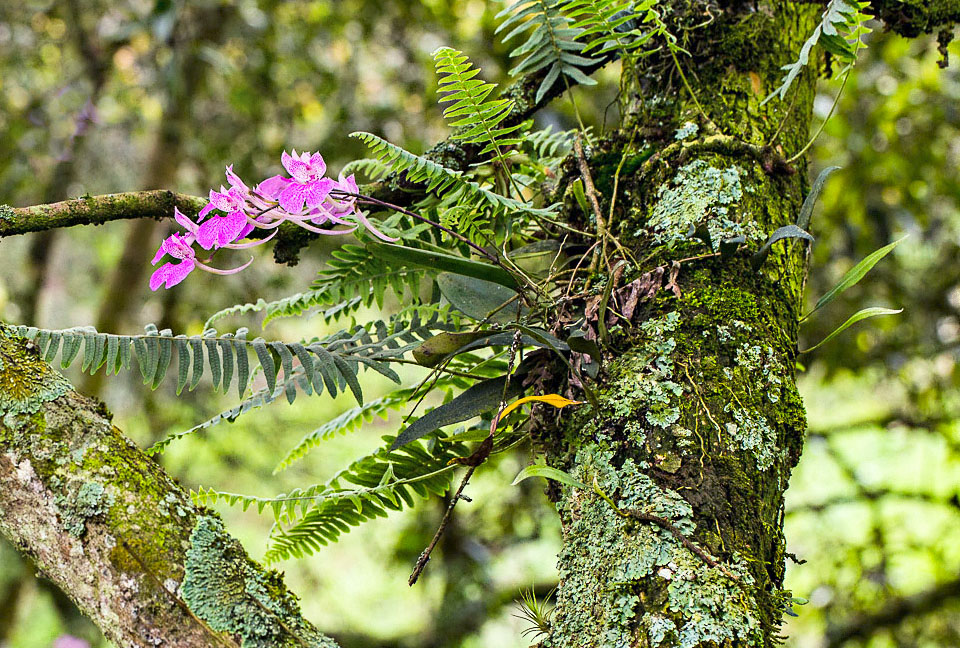
Camparettia macroplectron is an epiphyte endemic to Colombia mountains between 1800 and 2500 m, but probably its range is ampler © Sebastian Vieira-Uribe
Comparettia macroplectron Rchb.f & Triana (1878) is a species of the family Orchidaceae, subfamily Epidendroideae, tribe Cymbidieae, subtribe Oncidiinae, endemic to the Colombian territories included in the departments of Boyacá, Meta and in Cundinamarca (Choachí, Fómeque, Ubaque e Cáqueza).
It is also probable that its distribution range may be ampler but there is no confirmation to date.
It is found near the water courses, in the humid tropical biome, at altitudes going from 1500 to 2500 m above the sea level.
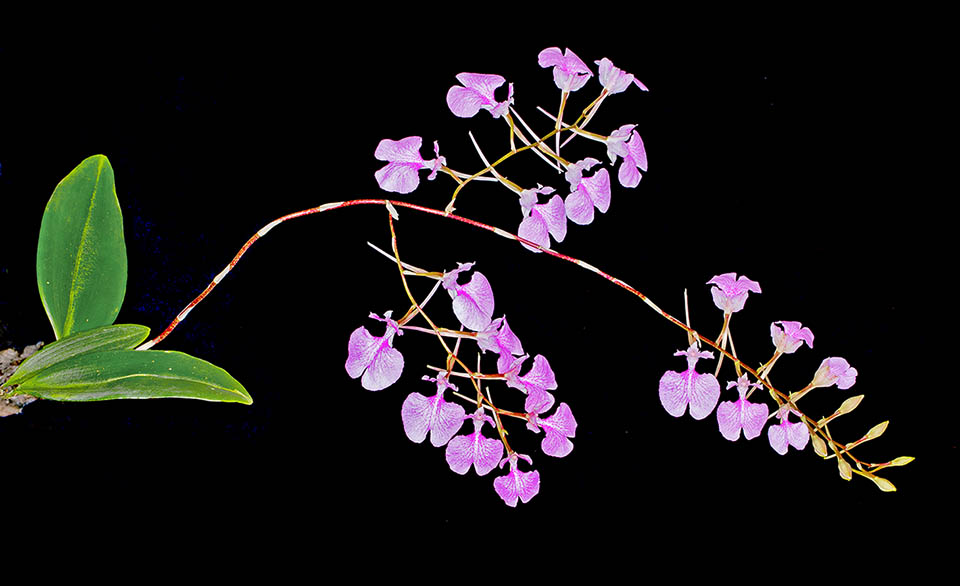
The very short pseudobulbs bear 2-3 leaves about 7,5 cm long. The inflorescence, arcuate, reaches the 35 cm, at times irregularly ramified © Giuseppe Mazza
It lives on various species of shrubs such as the Common guava (Psidium guajava L., 1753) and the White myrtle (Myrcianthes leucoxyla (Ortega) McVaugh) that with its rough bark and with its thick foliage allows a very vigorous growth.
The genus was described in 1836 in the great opus in three volumes Nova genera ac species plantarum, quas in regno Chilensi Peruviano et in terra Amazonica (Nov. Gen. Sp. Pl vol. 1 p. 42,1836) by the German botanist, zoologist and explorer Eduard Friedrich Poeppig (1798-1868) and by the Directorof the Vienna Botanical Gardens, Stephan Ladislaus Endlicher (1804-1849). In these volumes are presented to the readers all the species discovered by them during their voyage in Chile and in Peru from 1827 to 1832.
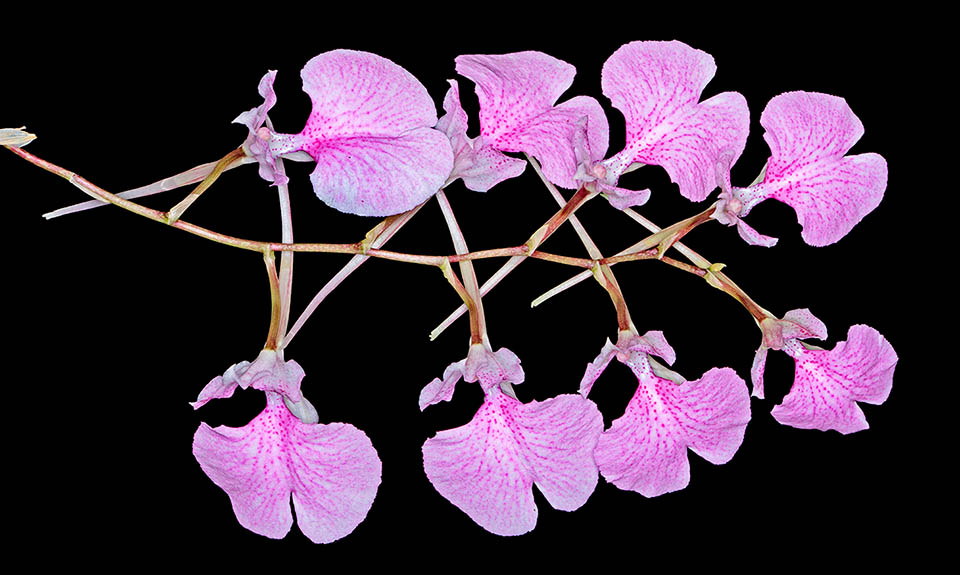
Detail with 8 pink flowers having darker spots well arranged in an elegant ramification waiting for pollinators © Giuseppe Mazza
The genus Comparettia has been recently expanded due to transfer, based on DNA data, of species of the genera: Diadenium, Chaenanthe, Scelochilus, Neokoehleria, Scelochiloides, Stigmatorthos, Pfitzeria, Scelochilopsis. In this way Comparettia counts presently about 80 species diffused in Belize, Brazil, Colombia, Costa Rica, Cuba, Guatemala, Honduras, Mexico, Peru, Puerto Rico, Venezuela.
Comparettia macroplectron was discovered in 1878 in Colombia by José Jerónimo Triana Silva (1828-1890), Colombian explorer and physician who for seven years travelled a large part of Colombia, succeeding in collecting about 60.000 specimens, many of which belonging to species new for the Science.
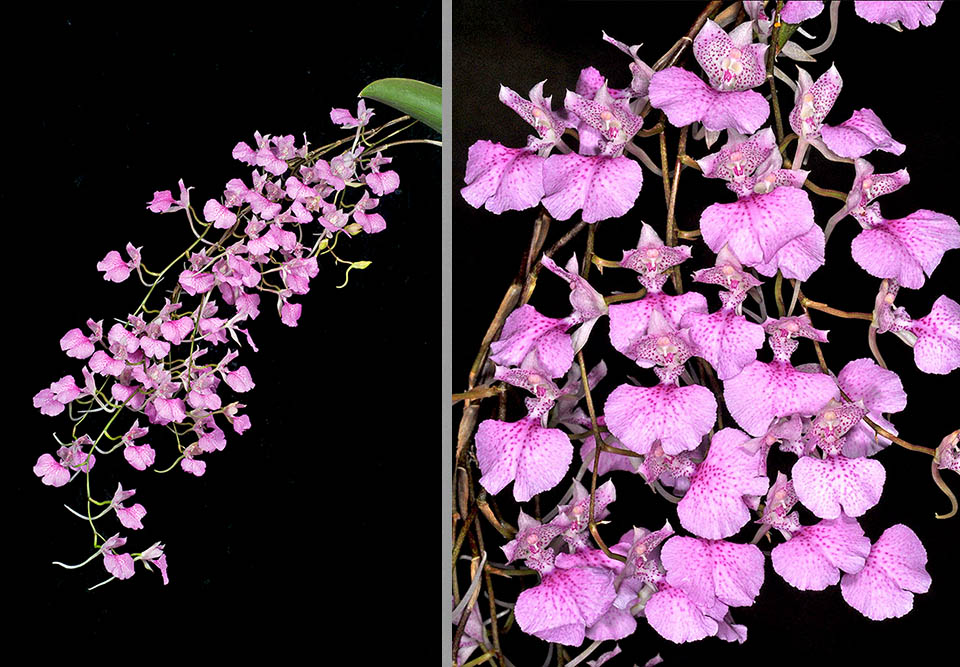
These ramifications, overlapping, may, especially in cultivation, form impressive floral masses © Eric Hunt (left) and © Ron Parsons (right)
Triana has been author of several volumes like Podromus Florae Novo-Granatensis (1865) and Mémoire sur la famille des Guttifères (1862).
He was member of the Botanical Society of France (1858), juror of the International Exposition of the Horticulture of Amsterdam (1865); Vice President of the International Botanical Congress held in London (1866); member of the Society of Agricultura of France (1883), General Consul of Colombia in Paris from 1874 until his demise, occurred on October 31st, 1890.
The other author of the species was Heinrich Gustav Reichenbach (1823-1889), certainly the most important German orchidologist of the XIX century.
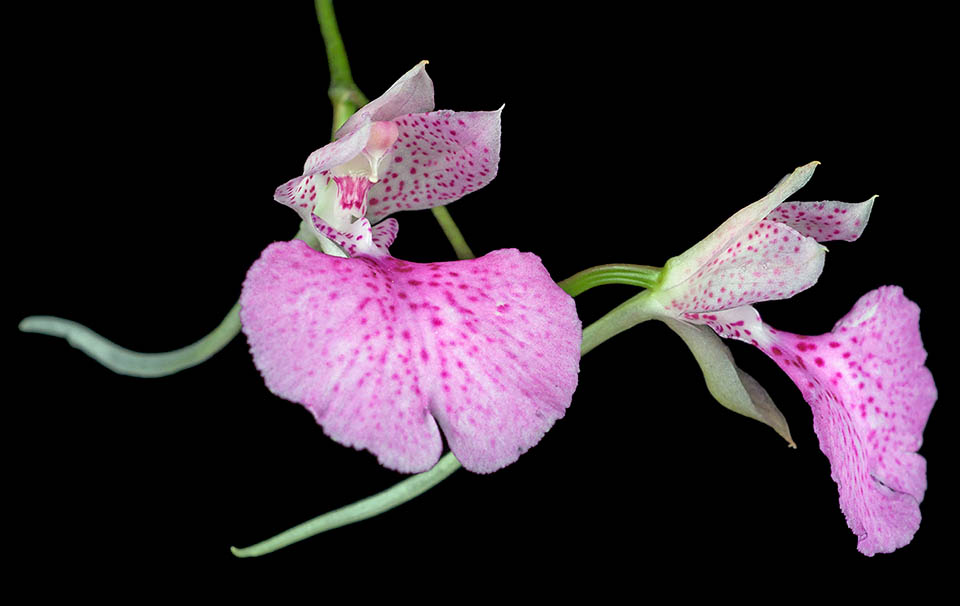
Two flowers seen from side. We note the long spur formed by the fusion of the lateral sepals, similar to a huge whip as states the scientific name © Eric Hunt
He left his immense herbarium and his library, with the collection of the original drawings of the species he had studied and described, to the “K.k. Naturhistorisches Hofmuseum” (Imperial Natural History Museum ) of Vienna with the obligation that no one could access it during the first 25 years after his death. In fact, to justify this, in his will he wrote: ” … to avoid the inevitable destruction of the expensive collection resulting from the present mania for the orchids”. However, such diligence seemed hardly credible given the importance and the seriousness of the Museum. Probably the unusual prescription was for preventing some young colleague, perhaps Robert Allen Rolfe (1855-1921) of Kew Gardens, for whom he had little esteem, to take possession of his discoveries.
The name of the genus was chosen to honour Andrea Comparetti (1745-1801), physician, botanist and plant physiologist, professor in Padua, author of the Prodromo di fisica vegetale (Bortolamio, 1791).
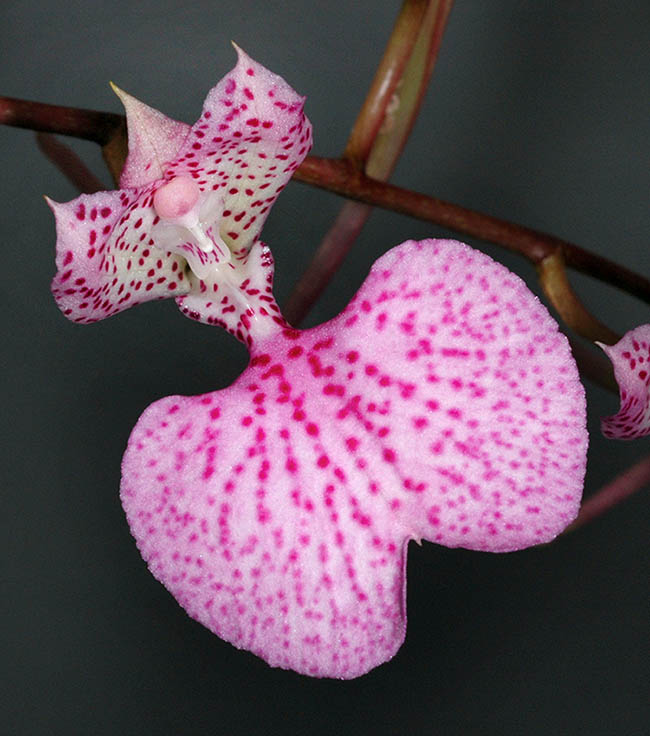
In front is visible the showy labellum merged at the base of column with an apical operculated anther © Eric Hunt
The specific epithet macroplectron comes from the Greek “μακρός” (makrós) long, big and from the Latin “plectrum” (from the Greek πλῆκτρον, der. of πλήσσω (plêktron) that indicates any object to hit with, here with reference to the presence of the “great spurs” of the flowers similar to a whip.
The common name in English is “The Large Spurred Comparettia”.
Comparettia macroplectron is an epiphytic species of little dimensions, hanging, with very short pseudobulbs carrying 2 to 3, about 7,5 cm long, ligulate, oblong or oblong and obtuse leaves. The inflorescence is basal, arcuate, upto 35 cm long, at times irregularly ramified, with 4 to 8 flowers of medium size that appear in the middle of winter. The 3,5 x 2,5 cm flowers are dark pink with darker dots, resupinate, with sepals of equal length, in vertical position, well spread out and open.
The dorsal sepal is free, the lateral ones are merged and extended in an about 4 cm long and thin spur. The petals are like the dorsal sepal, but wider. The labellum, 35 mm long and 25 mm broad, is continuous with the base of the column, trilobed, of cherry red colour and with numerous darker dots and toothed sides. The lateral lobes are very small, the median is ample and toothed.
The column, white, is semicircular without wings or foot. The anther is unilocular, opercular with two grooved pollen masses, stuck to a peduncle shaped like an elongated cone, ending in an oval reticulum.
Blooming begins during the month of November and lasts 60 to 80 days. The chromosome number is 2n = 56. The photosynthesis is of CAM type (Crassulacean Acid Metabolism), implemented as an adaptation to the excessive loss of water (xerophytic adaptation). In this way the process of photosynthesis takes place with closed stomata that, conversely, open during the night for the gas exchanges (CO2, O2) with a minimum loss of water vapour.
Comparettia macroplectron is commercially protected and as such is inserted into the Appendix II of the Washington Convention (CITES) that has the purpose of protecting the animal and vegetable species under risk of extinction, forbidding their export and detention.
In cultivation it grows well in a small suspended basket, in a net pot or on plates, with a lot of air around the roots.
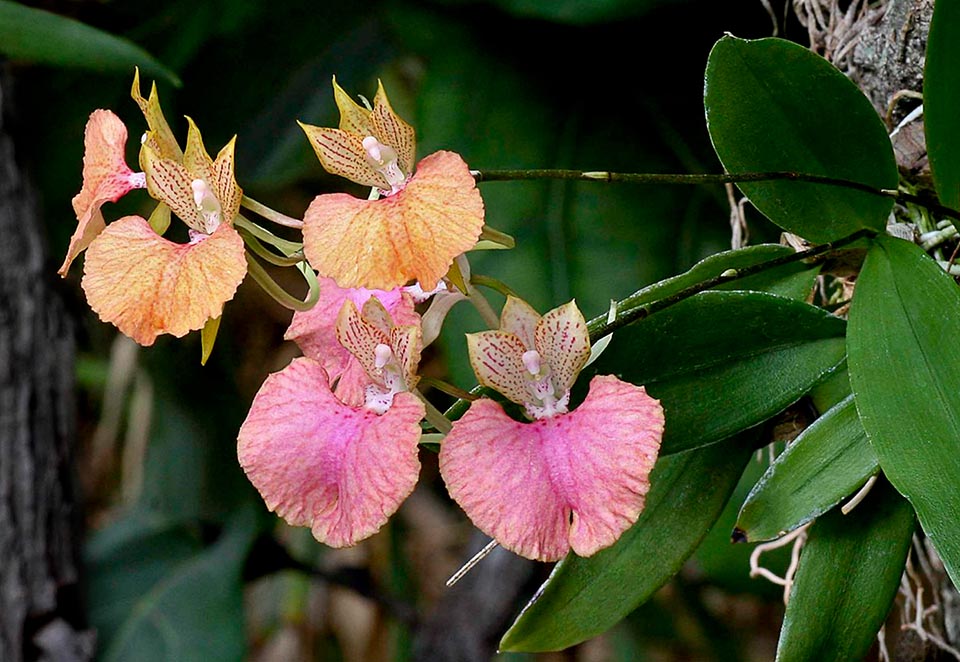
This hybrid of Comparettia falcata x Comparettia macroplectron has flowers changing over time after the parents prevailing characters © Manuel Lucas García
This species is cultivated in a temperate-warm environment. It is suggested to lightly shade the plant when the sun is stronger during the summer. The shading must be removed as soon as there is no more direct sunlight on the greenhouse or when the sun has lost its strength. The substratum must be of the type suitable for epiphytic orchids (i.e. maritime pine or fir bark, tree fern fibres), with addition of sphagnum moss to allow the moisture retention and in the meantime to guarantee the ventilation.
The plants are to be irrigated regularly (twice or thrice a week) during the growth season, but in winter, the compost must be maintained less humid, but it should never dry up completely. The fertilization is to be done with soluble organic products but, being small plants, it’s a good thing to use them moderately.
Several hybrids registered at the Royal Horticultural Society do exist. Among these, we mention: Comparettia Higashiyama, Y.Hattori 1980 (RHS) (Comparettia macroplectron×Comparettia coccinea) is a hybrid created in Japan in 1980 by Y. Hattori.
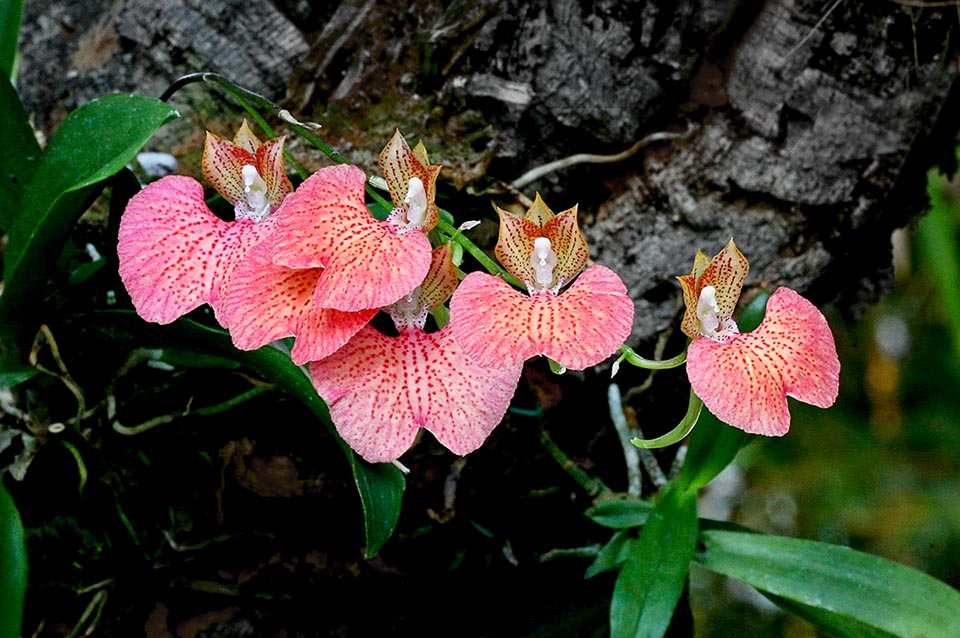
Comparettia Oberhausen is a known primary hybrid obtained by cross between Comparettia macroplectron x Comparettia speciosa © Manuel Lucas García
The name Higashiyama means eastern mountain. The plant has elegant leaves with reddish shade and has nice flowers, long lasting, 3-5 cm big of colour varying from orange to pink. The plants of this hybrid are vigorous and grow better in the New Zealand sphagnum moss, or mounted on plates.
Comparettia Oberhausen, W.Baumann 1984 (RHS) is a primary hybrid obtained by W. Baumann by crossing between Comparettia macroplectron × Comparettia speciosa.
Gomettia Tropical Jujubees, Trop.O.Farm 2008 (RHS) is a hybrid of Gomesa echinata × Comparettia macroplectron.
Comparettia Teipels Feuerglut, P.Teipel 2012 (RHS) is a beautiful secondary hybrid of orange colour obtained by crossing Comparettia Oberhausen × Comparettia speciosa.
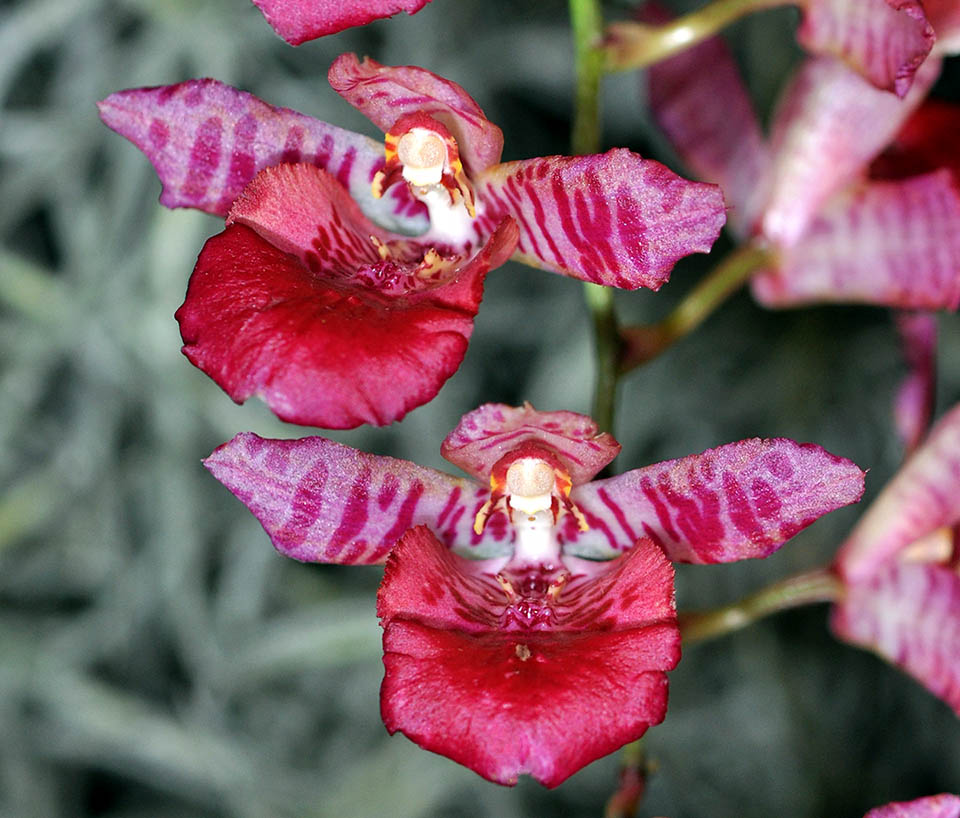
The spectacular Gomettia Tropical Jujubees is an unusual hybrid of Gomesa echinata × Comparettia macroplectron © Norbert Dank
The recently awarded cultivars are: Comparettia macroplectron ‘Mon Cheri’ (2 premi nel 2016), Comparettia macroplectron ‘La Plata’ (2 premi nel 1977), Comparettia macroplectron ‘Huntington’s Pinke’ (2019), Comparettia macroplectron ‘Bellenberg’ (2018), Comparettia macroplectron ‘Sanyi’ (2016), Comparettia macroplectron ‘Orquifollajes’ (2015), Comparettia macroplectron ‘Windflower’ (2013), Comparettia macroplectron ‘Lee Langland’ (2012), Comparettia macroplectron ‘Seo Ha’ (2010), Comparettia macroplectron ‘Pandora’ (2009), Comparettia macroplectron ‘Susi’ (2007), Comparettia macroplectron ‘Leo’ (2002), Comparettia macroplectron ‘Breathe of Spring’ (1999), Comparettia macroplectron ‘J & L’ (1985), Comparettia macroplectron ‘Ocean Pines Pinky’ (1982), Comparettia macroplectron ‘Pink Butterfly’ (1981), Comparettia macroplectron ‘Lauray’ (1979), Comparettia macroplectron ‘Lucille’ (1973), Comparettia macroplectron ‘Monroe’ (1972), Comparettia macroplectron ‘Rudolf’ (1967).
